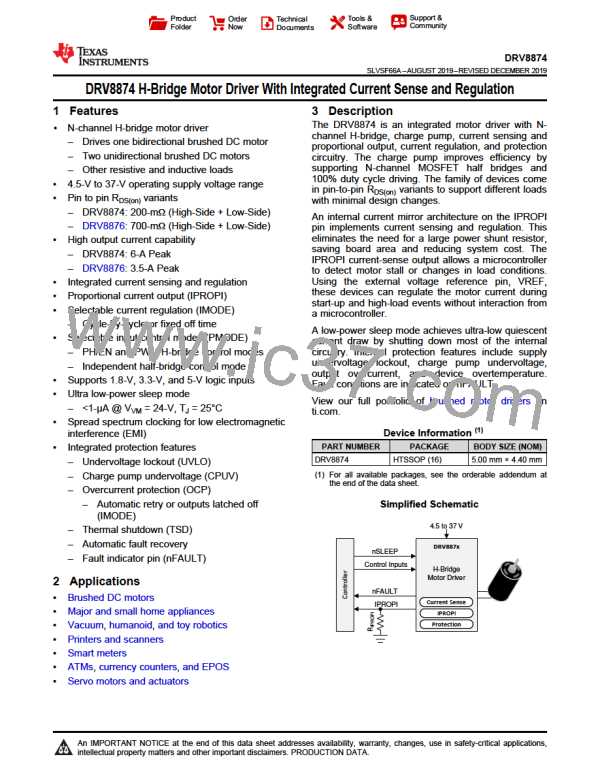DRV8874
SLVSF66A –AUGUST 2019–REVISED DECEMBER 2019
www.ti.com
11
10.5
10
40
38
36
34
32
30
28
26
24
4L 1oz
4L 2oz
4L 1oz
4L 2oz
9.5
9
8.5
8
7.5
7
6.5
0
2
4
6
8
10
12
14
16
0
2
4
6
8
10
12
14
16
Top layer copper area (cm2)
Top layer copper area (cm2)
4L_R
4L_P
Figure 21. HTSSOP, 4-layer PCB junction-to-ambient
thermal resistance vs copper area
Figure 22. HTSSOP, 4-layer PCB junction-to-board
characterization parameter vs copper area
30
27.5
25
160
2L 1oz
2L 2oz
2L 1oz
2L 2oz
140
120
100
80
22.5
20
17.5
15
12.5
10
60
40
7.5
5
20
0
2
4
6
8
10
12
14
16
0
2
4
6
8
10
12
14
16
Top layer copper area (cm2)
Top layer copper area (cm2)
2L_R
2L_P
Figure 23. HTSSOP, 2-layer PCB junction-to-ambient
thermal resistance vs copper area
Figure 24. HTSSOP, 2-layer PCB junction-to-board
characterization parameter vs copper area
8.2.1.2.3.2 Transient Thermal Performance
The motor driver may experience different transient driving conditions that cause large currents to flow for a short
duration of time. These may include
•
•
Motor start-up when the rotor is not yet spinning at full speed.
Fault conditions when there is a supply or ground short to one of the motor outputs, and the device goes into
and out of overcurrent protection.
•
Briefly energizing a motor or solenoid for a limited time, then de-energizing.
For these transient cases, the duration of drive time is another factor that impacts thermal performance. In
transient cases, the thermal impedance parameter ZθJA denotes the junction-to-ambient thermal performance.
Figure 25 and Figure 26 show the simulated thermal impedances for 1-oz and 2-oz copper layouts for the
HTSSOP package. These graphs indicate better thermal performance with short current pulses. For short
periods of drive time, the device die size and package dominates the thermal performance. For longer drive
pulses, board layout has a more significant impact on thermal performance. Both graphs show the curves for
thermal impedance split due to number of layers and copper area as the duration of the drive pulse duration
increases. Long pulses can be considered steady-state performance.
24
Submit Documentation Feedback
Copyright © 2019, Texas Instruments Incorporated

 TI [ TEXAS INSTRUMENTS ]
TI [ TEXAS INSTRUMENTS ]